St Kevin's Reformatory School, Glencree, near Enniskerry, Co. Wicklow, Ireland
St Kevin's Reformatory School for Roman Catholic Boys was established in 1859 at Glencree, in the Wicklow mountains near Enniskerry in County Wicklow. The School, which was Ireland's first such institution for boys, was instigated by the Dublin Catholic Reformatory Committee. The site at Glencree, which included an abandoned army barracks together with 100 acres of land, was leased for then purpose from Lord Powerscourt.
The Committee then approached a religious order, the Oblates of Mary Immaculate, to run the School. The Oblates had been founded in France in 1826, then in 1854 had established a mission in Ireland. Although the Oblates were known to be concerned for the poor, they had no experience of running a Reformatory. However, they visited the penal settlement at Mettray in France, where the boys lived in 'families' under the charge of a house-father. There was a regime of hard work and severe punishment for misconduct. Unfortunately, the nature of the large barrack blocks at Glencree did not lend itself to the small-unit style of organisation. On April 12th, 1859, St Kevin's was officially certified to receive up to 290 boys, aged from 11 to 13, who had been committed by the courts to a period of detention. The manager was the Rev. Francis J. Lynch.
At the outset, the buildings at Glencree were found to be in a very unsound state and required considerable expenditure to repair and extend them in order to make them suitable for use. The accompanying land was described as 'far from being of a productive nature' and in need of 'much toil' to make it at all productive. In October, 1861, 173 of the School's 239 inmates were engaged in reclamation work on the land. In 1871, the average number of inmates was 324. The staff at this date comprised the Superintendent, the Very Reverend Matthew Shinnors, nineteen Oblate Brothers, a chaplain, band master, tailor, carpenter, and four farm servants.
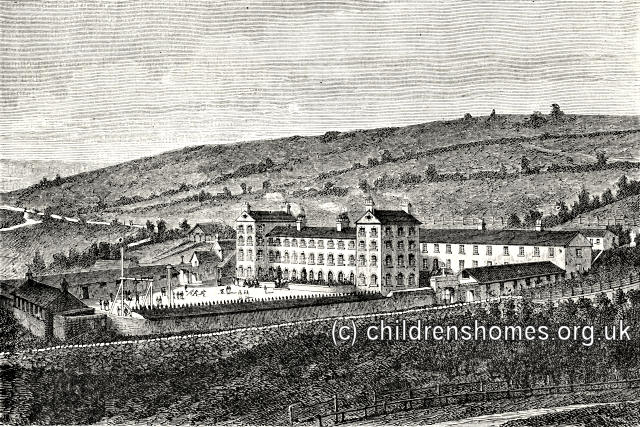
Glencree Reformatory entrance, c,1872. © Peter Higginbotham
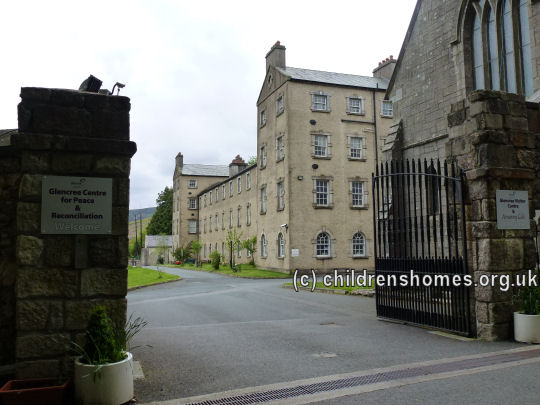
Glencree Reformatory entrance, 2014. © Peter Higginbotham
The original barracks comprised a central house running north-south which housed the School staff, a parallel boys' accommodation block at the west (now derelict), and a third block at the south-west (now a café and exhibition centre) which originally contained the barracks' armoury and other facilities. Most of the new buildings (refectory, laundry, lavatory, school-rooms, kitchen, bake-house, workshops etc.) were placed along the south and east creating a quadrangle. Additions to the premises in 1881-82 included a play-hall, band room, and showroom for manufactured articles, with part of the central house being converted to an infirmary. The School had its own reservoir on the hillside at the north-west of the site. It also operated a gas manufacturing plant to provide lighting. The layout of the buildings in around 1910 is shown on the map below.
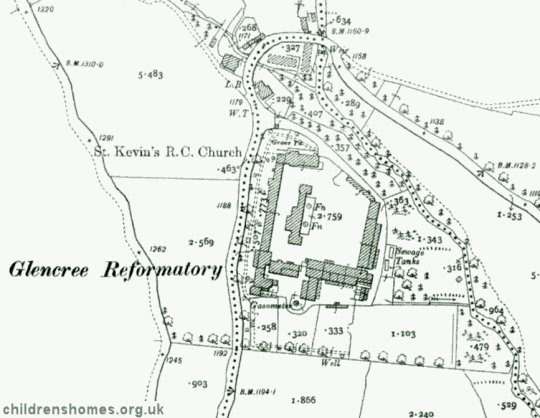
St Kevin's Reformatory School site, Glencree, c.1910.
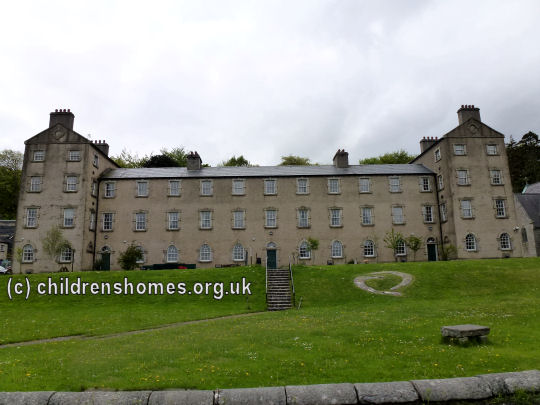
Glencree Reformatory central house from the east, 2014. © Peter Higginbotham
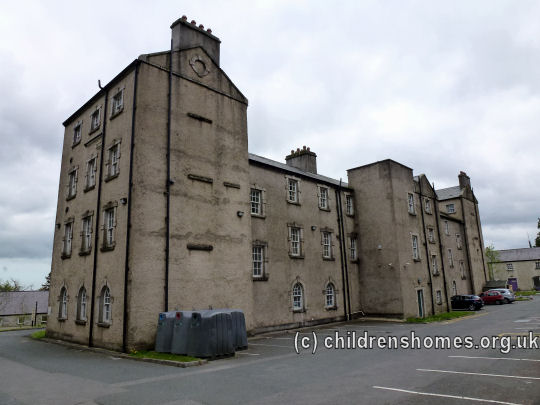
Glencree Reformatory central house from the north-west, 2014. © Peter Higginbotham
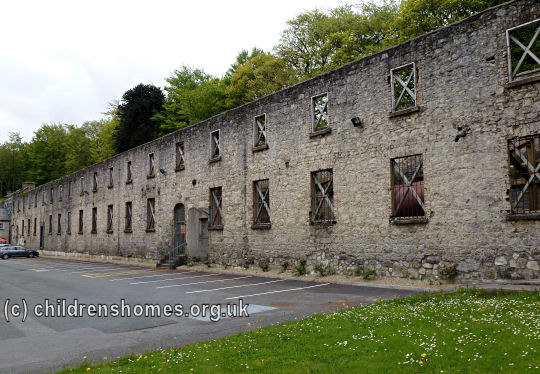
Glencree Reformatory western range from the north-east, 2014. © Peter Higginbotham
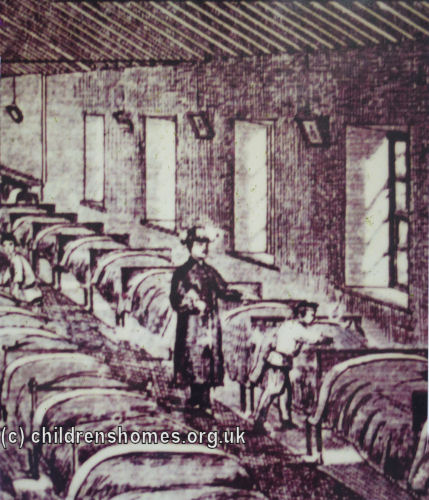
Glencree Reformatory dormitory, date unknown. © Peter Higginbotham
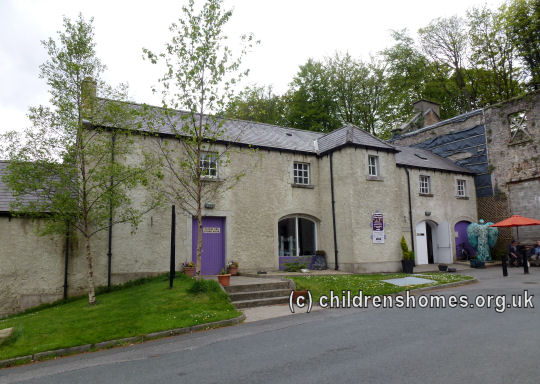
Glencree Reformatory armoury block from the north-east, 2014. © Peter Higginbotham
The School originally had a wooden chapel. This was replaced in 1872 by a stone building.
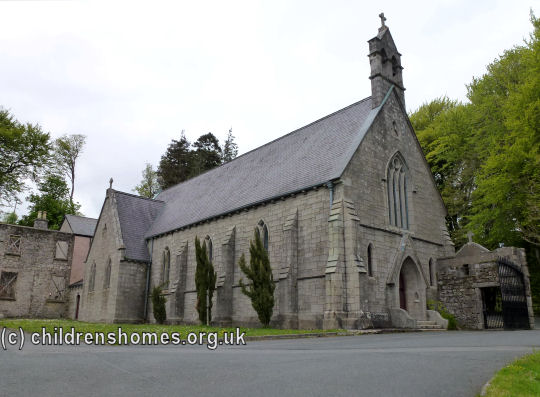
Glencree Reformatory chapel from the south-east, Glencree, 2014. © Peter Higginbotham
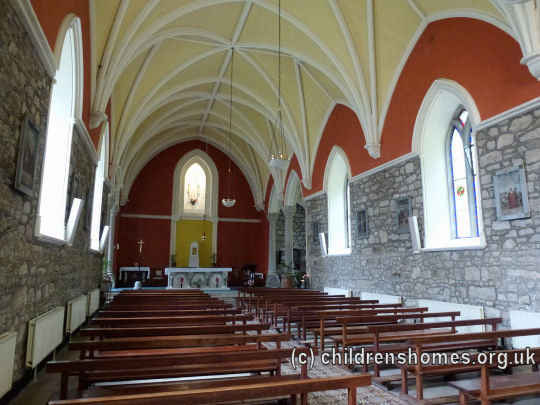
Glencree Reformatory chapel interior, Glencree, 2014. © Peter Higginbotham
Education at the School was under the management of a former National School teacher and the boys were taught reading, writing, ciphering and geography. Their industrial training included tailoring, carpentry, cabinet making, wood turning, quarrying, gas making, and agriculture. The shoes and clothing of the staff and inmates were entirely made by the boys. A fife and drum band was also formed with the purchase of instruments funded by charitable donations.
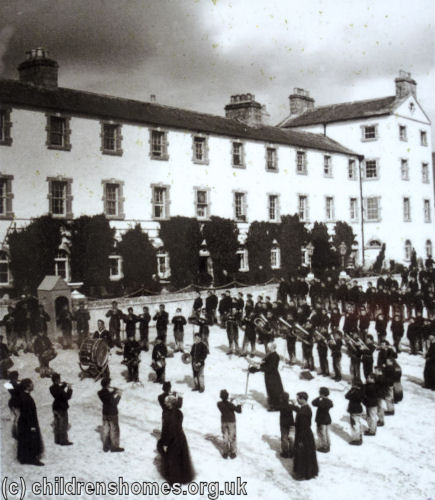
Glencree Reformatory band, date unknown. © Peter Higginbotham
In 1865, Glencree was visited by Matthew Davenport Hill, the Recorder of the City of Birmingham and long-standing campaigner for penal reform. His Journal entry describing the occasion is reproduced below.
JULY 28TH, 1865.—Visited the Reformatory for Roman Catholic Boys at Glencree, twelve miles from Dublin. It was opened in April, 1859, under the management of the Rev. Mr. Lynch, who continues to be its Director.
The drive from Bray to Glencree occupied about two hours, as it involves an ascent to nearly the summit of the Glencree Mountains, where an old barrack (dating from the troublous times of the last century) has been converted to the purposes of the School. The land surrounding it was unreclaimed bog and heath, but is being brought gradually into cultivation by the labour of the boys; and a portion bounded by the road is enclosed by an excellent stone wall which they have built. This work and their fine crop of potatoes on a steep hill-side, which was waste land last year, were pointed out by our driver, who seemed to take a deep interest in the School, and assured us there had only been "three or four bad boys" there since it opened.
The School itself—one long range, with an enclosed court in front forming the playground—reminded us much of Ruysselede [a reformatory institution in Belgium]; but it is not in such good order, having, in truth, an uninviting appearance. Additions have already been made to the edifice, besides repairs (indeed, as we were told, only one room was habitable when the School opened), and further buildings are being erected, so that in time the aspect of the establishment will be much improved.
We reached Glencree about 12 o'clock, when the lads were all at work, most of them at some distance from the house. They are reclaiming what our driver justly called a "hill of stones," some being very large boulders requiring to be shattered by blasting; and through this rocky land the lads had to cut drains as well as to clear the surface. Before beginning the reclamation, moreover, they had to make a zig-zag road up the face of the hill for conveying away rubbish and bringing agricultural implements and manure. The extent of land is a hundred acres, held under Lord Powerscourt, at an annual rent of £50, on a lease of 60 years. Mr. Lynch would like to have twice as much, though whether of the same barren character we doubt. From what he said of the difficulties undergone in adapting the old barracks to the requirements of a Reformatory, and of cultivating so sterile a soil, we conjecture that he agrees with M. Demetz [founder of the agricultural colony at Mettray, France] that the buildings should be erected specially for their object, and that the land should be as fertile and easy to work as can be obtained. That buildings should be well adapted to their purpose cannot be disputed; such adaptation, indeed, is of great importance. But we must own we were in some degree shaken with regard to the expediency of choosing land because of its fertility. M. Demetz is strongly in favour of employing the lads on fertile soil, and his authority goes far with us. But the advantages of a bracing climate and of remoteness from any town or populous village, does much in the instance of Glencree to countervail many disadvantages, to say nothing of the moral example constantly before the eyes of the workers of the conquest obtained by toil over almost insuperable difficulties.
We visited the schoolroom and principal dormitory—both long apartments—the latter the longest sleeping-room we ever saw. The beds are put as closely together as possible, allowing for passage; but an abundance of windows on each side supplies, in the opinion of the Director, ample ventilation. The room contains four large fire-places; and so severe is the cold at the altitude of Glencree that it is necessary during the winter to keep huge fires here night and day. The room is swept daily and washed twice a week. It was beautifully clean; and the beds, each made by its occupant, were perfectly neat. The lavatory is down stairs. As at Ruysselede, the family system of Dr. Wichern [founder of the Rahes Haus colony in Germany] and M. Demetz has not been brought into action. That it has many advantages cannot be controverted; and although it is doubtless more expensive than the congregate system, it was after due investigation substituted at Redhill for the cheaper plan, even when the change involved considerable expensive alterations.
The schoolroom has a high dais at one end, which enables the master to overlook all his pupils with ease. It is used also at Christmas as a stage for theatrical representations, the master writing the plays which the pupils act.
The boys do the whole work of the house. We found one of them in the kitchen busy in preparing dinner; being Friday the food was vegetable soup. One or two lads were at work in the wash-house. They use no washing-machine, but have one for wringing, and a mangle. There are also hot drying closets. Ironing is a process dispensed with.
Glencree is lighted throughout by gas made on the premises. The apparatus is entirely managed by one of the lads, and it occupies his whole time, except what he passes in school. School-time employs about 3½ hours each day in summer, and more in winter. Some few of the pupils, Mr. Lynch told us, are studying mathematics, and many reach the higher branches of arithmetic. There is a library open to the use of those who acquire and retain the privilege by good conduct. Many of the books are Roman Catholic works, but there are also several of unsectarian character. One of the lads is librarian, and attended to open the bookcase for our inspection. Some of the boys are taught the art of chair making in a large, airy shop fitted with a lathe, and all tools proper for the manufacture. The chairs are for sale; and a strong, well-made specimen was pointed out to us as having been entirely constructed by one of the boys.
The pupils were practising band-music when we entered the music-room, as we presume it is called. The array of instruments stored in its presses was very large, and the master who teaches music has his whole time thus occupied. It was the brass band to which we were now listening (there is a fife band also), and about twenty-four youths were performing. They played marches and dance music with great spirit and precision, but an operatic fantasia was not so perfectly rendered.
The lads are building a new stable and loft, and passing the spot where they were thus employed we entered the garden. It was well stocked with vegetables, boasted some flowers, and was in nice order—looking altogether so well-established that it was hard to believe it was the bare side of a mountain only six years ago.
The boys are instructed in all their occupations, except music, by lay brothers, and the staff of teachers is large. There is a genial, kindly tone throughout the little community, and Mr. Lynch seems to regard the lads almost as children of his own. They have a particularly healthy and cheerful appearance, being markedly superior—at first sight, at any rate—to the Ruysselede or even Mettray boys in this respect. In dress, it must be confessed, they looked dirty, but their agricultural work, road-cutting, peat-cutting, &c., makes this almost inevitable.
There is a tablet of honour on which are usually inscribed about 100 names out of 254, the total number of pupils. This is a smaller proportion than at Mettray. Inscription is obtained here, as there, by three months of good conduct.
The lads who come now are much more manageable than those received in the early days of the School, but out of all who have left only twelve have relapsed into crime. The death-rate is very low, only one in 200 per annum. Lads run away occasionally, but, with one exception, they have always been recaptured, or have returned of their own accord.
As one o'clock drew nigh, troops of twenty or thirty boys approached from different sides, accompanied by the lay brothers—not an unpicturesque sight up here among the mountains. They had cleansed their hands and faces and entered the refectory before we reached it, and the Angelus was reciting when we arrived. The prayer over, the boys fell to with a will. A large porringer, and huge piece of bread— lib. in weight—had been allotted to each place, and the soup was brought in from the kitchen hot and hot as it was wanted, the lads "asking for more"—and getting it—at pleasure. The scene had less military precision than at Ruysselede, but more, we think, of enjoyment. One of the lads sometimes reads aloud during meal times, but that was not so to-day.
After dinner the boys amuse themselves in the large court, and as soon as we were ready to witness it they were put through their drill, in which they acquitted themselves extremely well. After drill came a very good performance from each band, concluding with "God save the Queen" and "St. Patrick's Day." "We have two national airs," remarked one of the officers
In 1871, the School suffered a serious outbreak of smallpox which was introduced by a boy who had made a visit to his home in Dublin prior to his being released. Eventually, 61 boys contracted the disease, with two dying at the School and two others plus a night watchman dying at the Dublin smallpox hospital. To tend to the afflicted, a doctor, two trained nurses and two assistant nurses were brought in to provide round-the-clock care. Afterwards, clothing was destroyed and the buildings disinfected.
In 1881, arrangements were made with the Canadian Government to send a number of boys from the School over to Canada. The Archbishop of Toronto had promised that accommodation would be available for the boys until employment was found for them, and that local priests made it their business to look after young emigrants.
During the First World War, Glencree is said to have been used to house German prisoners of war.
By 1939, the accommodation and amenities at Glencree Reformatory were proving increasingly inadequate. There were only two dormitories for the 190 boys in residence and only four indoor lavatories. In winter, they had to dig their way through four feet of snow on occasions to get to the outdoor lavatories. There was no laundry, so that clothes could not be washed. The cost of rectifying these problems was such that in 1940 the institution was closed and the boys transferred to the Daingean Reformatory. The Oblates also departed from Glencree at this time.
During the Second World War, Glencree is said to have accommodated German military prisoners, including German air force pilots who had crashed in Ireland. In 1946, the premises were taken over as part of the Red Cross 'Operation Shamrock' scheme. The buildings were used as a reception centre for children from Germany who had been orphaned or displaced during the Second World War. After a period at Glencree, the children were found foster homes across Ireland though by 1949 most of the thousand or so children dealt with by the scheme had been returned to Germany.
Since 1975, the site has been home to the Glencree Reconciliation Centre. The former School chapel, now St Kevin's Church, has been taken over by the local parish.
Records
Note: many repositories impose a closure period of up to 100 years for records identifying individuals. Before travelling a long distance, always check that the records you want to consult will be available.
- Barnardo's Origins Tracing Service — for people (and their families) who spent all or part of their childhood in an Irish Industrial School and are interested in tracing information about their parents, siblings or other relatives.
- Irish Petty Sessions Court Registers 1828-1912 (available online to subscribers of FindMyPast) include details of committals to Irish Reformatories and Industrial Schools.
Bibliography
- Arnold, Mavis, and Laskey, Heather Children of the Poor Clares (2004, Appletree Press)
- Barnes, Jane Irish Industrial Schools 1868-1908 (1989, Irish Academic Press)
- Dunne, Joe The Stolen Child: A Memoir (2003, Marion Books)
- Rafferty, Mary and O'Sullivan, Eoin Suffer the Little Children: The Inside Story of Ireland's Industrial Schools (1999, New Island Books)
- Touher, Patrick Fear of the Collar: Artane Industrial School — My Extraordinary Childhood (1991, O'Brien Press)
- Tyrrell, Peter and Whelan, Diarmuid Founded on Fear: Letterfrack Industrial School (2006, Irish Academic Press)
- Wall, Tom The Boy from Glin Industrial School (2015, Tom Wall)
Links
- Glencree Reconciliation Centre (former Reformatory site)
- The Commission to Inquire into Child Abuse
Except where indicated, this page () © Peter Higginbotham. Contents may not be reproduced without permission.


